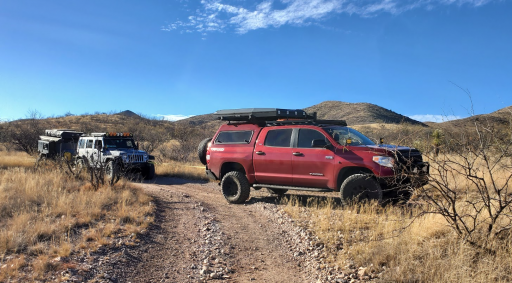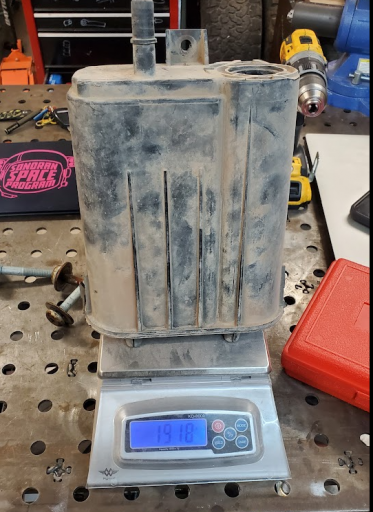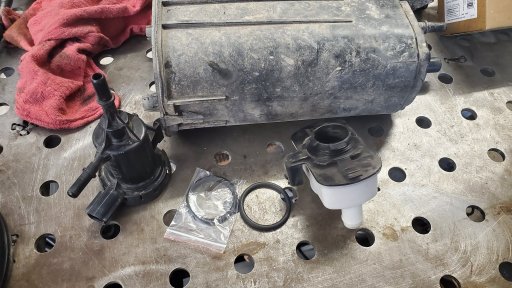
Off-Road Ranger I
If you are like me, you have an EVAP system in your rig. Even if you're not like me, you still have one, unless you are one of those cool Rivian or F150 Lightning folks or are driving something made before the 70s. If you are also like me, you know jack sh*t about the nitty gritty details of the EVAP system. For the last 18-24 months or so I've been chasing down a mysterious (to me) issue with my Jeep JKU's EVAP system. This thread might be part informative, part inquisitive, and most likely an EVAP therapy support group.
This thread might be especially relevant if you have a JKU with a Genesis Offroad Dual Battery setup and/or a Long Range America expedition auxiliary fuel system.
First off, what is the EVAP system. The EVAP system captures fuel vapor instead of letting the fuel vapors escape into the atmosphere. The vapor is captured in a sort of Ghostbuster's containment unit called the "EVAP canister" or "charcoal canister". Eventually, the canister collects enough vapor that it needs to be purged, at this point, some valves are moved around automagically by the PCM, and the vapor is shipped to the engine to be burned off.
Here's a picture i found of a typical evap system. look at it. wow. so cool. ... wait, is that urine in the gas tank?
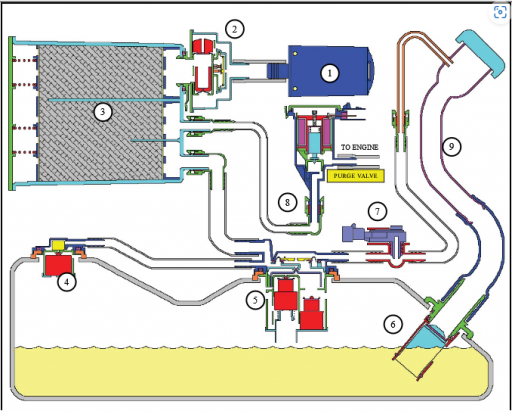
The primary pieces relevant to my journey so far are:
2) Leak Detector Pump / Evap Valve (normally open)
3) Evap canister
8) Purge Valve / Purge Solenoid (normally closed)
Uncredited Performance) Fuel filler cap (normally closed)
These are kind of the heart and soul of the evap system. When the canister (3) needs to be purged, the purge valve (8) and the evap valve (2) are both opened to create a drinking straw where the engine vacuum sucks the vapors from the canister through the purge valve into the engine's intake manifold, and the open evap valve on the other end allows clean fresh air to be pulled through the canister to replace the icky vapors. if any part of this straw is not working, things go bad. I should also note that this "straw" is sometimes closed on both ends by the PCM to either create a vacuum or to pressurize the tank, and again, if any valves are not working properly, this can lead to leaks. All modern gas engines also have leak detection capability. If any part of this system is unhealthy, you're likely to get poor engine performance, and eventually error codes and a check engine light.
Since I first started noticing an issue, I've received a number of OBD-II codes, here's the ones that I can recall seeing for sure:
P0454 P0456, P0440, P0455, P0442: evap leak detected - specific code describes what type of leak
P0171, P0174: fuel mix too lean (bank 1, bank 2)
P0172, P0175: fuel mix too rich (bank 1, bank 2)
P0411: incorrect purge flow
P0401: insufficient exhaust gas recirculation (EGR) flow
I have had the joy of experiencing nearly all of those.
Now it's time for the backstory of my experience, since it started small, got worse, and then got really really bad to the point where we were regularly stranded on the side of a highway or in the middle of nowhere down a trail. Thankfully (in m case, at least) letting the vehicle sit turned off for an hour or so usually got us back moving again, but in the worst case we had, we were stuck on the side of a highway (my wife and i and our three kids) for about 3 hours in the dead heat of the AZ summer. not fun. here's a pic.

The issue was always worse the hotter it got or the higher we went up the mountains. The absolute worst case scenario was when we would fill up on the desert floor (~2500ft elevation) on a hot summer day (~110F) and then with full fuel tanks we would drive up to the top of a sky island (~8-10k ft elevation). The full tanks meant less room for vapor to expand, and the heat made the vapor vaporize faster. This was an almost guaranteed recipe for us to get stuck with an evap issue.
The first time i noticed any issue with the evap system was when we got a small evap leak code (P0456) and a CEL, this was years ago. I looked up the code, saw people pointing to the garbage evap leak detector pump that comes on Chrysler vehicles, so $40 and literally two minutes of work to swap it out, the problem was solved (on the Wrangler it is incredibly easy to replace, no tools required). Here in AZ, our trails are exceptionally dusty since we never see rain, so I suspected the dust clogged up the mechanism and killed it. Seemed to be consensus from a few other people I talked to in the area who also had the same issue as well.
Next up was driving back from Overland Expo in Sept 2021. This is when i believe, in hind sight, that my major evap issues really started up. I started noticing while driving from Flag back down to Tucson that whenever my RPMs would increase past about 2500 RPM that there was a momentary stutter and lag in the engine. It happened probably 25% of the time my RPMs went past 2500 or so. The trip up to Flag had been our traditional "Expo the hard way" with the Herd of Turtles where we drive about 160 miles of dirt from Phoenix to Flagstaff to get to expo. I remember it being a much dustier trip than typical, so we were basically driving in a non-stop haboob for three days.
It was literally this for 160 miles, the wild flowers were amazing at least:
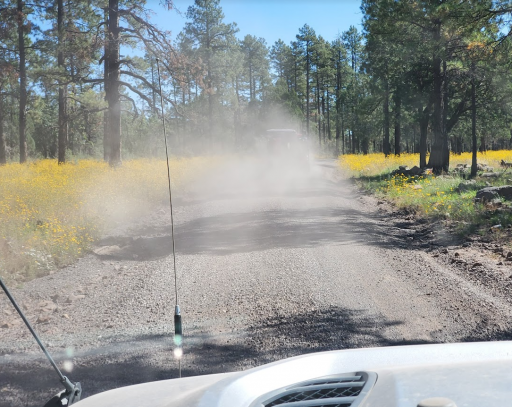
A few months after this, we started noticing that when we would roll up to camp, if I left the jeep idling while i was disconnecting and leveling the trailer and such, when it was time for me to hop back into the jeep to move it i would give it gas and then it would immediately stall out. Typically no CEL, and no OBD-II codes. If i let it sit for 10-15 minutes, it would run just fine again. Wasn't a big enough hassle so I would just kinda shrug my shoulders and think "that was strange, oh well, back to ignoring the fact that there might be a problem"
Around the same time, we would almost always notice the smell of fuel vapor when rolling up to camp, and sometimes if i loosened the gas cap, i could hear pressure releasing from the tanks. interesting, probably related, but nonetheless, no codes and no CEL meant "dear brain: don't worry about this. surely the truck will tell me when there's an actual issue by illuminating the CEL"
Eventually this was happening on every trip.
To complicate the matter, around this same time, I started having some issues with my MAF sensor and my cam position sensor. my MAF was super dirty so i cleaned that out solving that problem. The cam position sensor took a bit longer to investigate and troubleshoot. Have you ever taken your 3.6L Pentastar apart like 4 or 5 times? Yeah, me too, super fun! Eventually I discovered that my timing chain had stretched nearly a half-link, so I had the joy of nearly completely taking apart my engine and learning how to replace the timing kit. baptism by fire. I think I'm now officially a YouTube Certified Master Automotive Mechanic though, which is awesome.

Ok, anyway, back to the story. After the timing issue was all sorted, the evap issue was still a thorn in my side. For nearly two years now i had been tracking this issue down and bashing my head against a wall trying to figure it out with my very limited mechanic experience. It started as a grain of sand in my shoe, and by now it was starting to become a sharp piece of glass in my shoe. I was starting to note down symptoms and desperately searching Google for anybody having a similar problem. For future people googling, here's some food for the search engine so that they may find this thread and maybe find a solution to their problem, too.
The scenario that almost always produced the problem was a pretty long day of driving, either down the highway or down the trail, lots of long idling at any point. For us, we would typically idle the vehicle when at gas stations, for example, to keep the AC going for the kids and pets. Sometimes it would sit there idling for 30-45 minutes. The hotter the weather or the higher the elevation gain, the more likely we would see an issue, and a guaranteed way to have an evap issue was to think that i solved it, load my family up, and head out on a far away trip. The crankier the kids, the more likely.
The resulting symptom was always the same, at some point, the engine would start sounding really bogged down, severely loose power, and then within a couple of minutes, it would stall and not be able to start again. If we let it sit for an hour or so, it would eventually start up again, but often it was only a matter of time before it would stall back out 20 or 30 minutes later. Sometimes this would be accompanied by overpressurized fuel tanks, so cracking the gas cap would let a rush of pressure out, sometimes fuel would spray out with it. Lemme tell you, the wife and kids love nothing more than when i get back into the car smelling like Chris Farley after doing the gas station flashdance. I'm a maniac indeed.
I saw mention in one jeep forum about this exact scenario and the suggestions were to slightly crack the gas cap and leave it that way. Obviously that was not a permanent solution, but it did get us by for quite a while. The problem still became more and more common. A few months back while troubleshooting, we noticed we could recreate the issue by running the purge valve test on my OBDII scanner. This led me to investigate the purge valve more deeply, and that's when I found the first smoking gun!
to be continued, this is getting long as heck and i don't want to hit a character limit... brb
This thread might be especially relevant if you have a JKU with a Genesis Offroad Dual Battery setup and/or a Long Range America expedition auxiliary fuel system.
First off, what is the EVAP system. The EVAP system captures fuel vapor instead of letting the fuel vapors escape into the atmosphere. The vapor is captured in a sort of Ghostbuster's containment unit called the "EVAP canister" or "charcoal canister". Eventually, the canister collects enough vapor that it needs to be purged, at this point, some valves are moved around automagically by the PCM, and the vapor is shipped to the engine to be burned off.
Here's a picture i found of a typical evap system. look at it. wow. so cool. ... wait, is that urine in the gas tank?

The primary pieces relevant to my journey so far are:
2) Leak Detector Pump / Evap Valve (normally open)
3) Evap canister
8) Purge Valve / Purge Solenoid (normally closed)
Uncredited Performance) Fuel filler cap (normally closed)
These are kind of the heart and soul of the evap system. When the canister (3) needs to be purged, the purge valve (8) and the evap valve (2) are both opened to create a drinking straw where the engine vacuum sucks the vapors from the canister through the purge valve into the engine's intake manifold, and the open evap valve on the other end allows clean fresh air to be pulled through the canister to replace the icky vapors. if any part of this straw is not working, things go bad. I should also note that this "straw" is sometimes closed on both ends by the PCM to either create a vacuum or to pressurize the tank, and again, if any valves are not working properly, this can lead to leaks. All modern gas engines also have leak detection capability. If any part of this system is unhealthy, you're likely to get poor engine performance, and eventually error codes and a check engine light.
Since I first started noticing an issue, I've received a number of OBD-II codes, here's the ones that I can recall seeing for sure:
P0454 P0456, P0440, P0455, P0442: evap leak detected - specific code describes what type of leak
P0171, P0174: fuel mix too lean (bank 1, bank 2)
P0172, P0175: fuel mix too rich (bank 1, bank 2)
P0411: incorrect purge flow
P0401: insufficient exhaust gas recirculation (EGR) flow
I have had the joy of experiencing nearly all of those.
Now it's time for the backstory of my experience, since it started small, got worse, and then got really really bad to the point where we were regularly stranded on the side of a highway or in the middle of nowhere down a trail. Thankfully (in m case, at least) letting the vehicle sit turned off for an hour or so usually got us back moving again, but in the worst case we had, we were stuck on the side of a highway (my wife and i and our three kids) for about 3 hours in the dead heat of the AZ summer. not fun. here's a pic.

The issue was always worse the hotter it got or the higher we went up the mountains. The absolute worst case scenario was when we would fill up on the desert floor (~2500ft elevation) on a hot summer day (~110F) and then with full fuel tanks we would drive up to the top of a sky island (~8-10k ft elevation). The full tanks meant less room for vapor to expand, and the heat made the vapor vaporize faster. This was an almost guaranteed recipe for us to get stuck with an evap issue.
The first time i noticed any issue with the evap system was when we got a small evap leak code (P0456) and a CEL, this was years ago. I looked up the code, saw people pointing to the garbage evap leak detector pump that comes on Chrysler vehicles, so $40 and literally two minutes of work to swap it out, the problem was solved (on the Wrangler it is incredibly easy to replace, no tools required). Here in AZ, our trails are exceptionally dusty since we never see rain, so I suspected the dust clogged up the mechanism and killed it. Seemed to be consensus from a few other people I talked to in the area who also had the same issue as well.
Next up was driving back from Overland Expo in Sept 2021. This is when i believe, in hind sight, that my major evap issues really started up. I started noticing while driving from Flag back down to Tucson that whenever my RPMs would increase past about 2500 RPM that there was a momentary stutter and lag in the engine. It happened probably 25% of the time my RPMs went past 2500 or so. The trip up to Flag had been our traditional "Expo the hard way" with the Herd of Turtles where we drive about 160 miles of dirt from Phoenix to Flagstaff to get to expo. I remember it being a much dustier trip than typical, so we were basically driving in a non-stop haboob for three days.
It was literally this for 160 miles, the wild flowers were amazing at least:

A few months after this, we started noticing that when we would roll up to camp, if I left the jeep idling while i was disconnecting and leveling the trailer and such, when it was time for me to hop back into the jeep to move it i would give it gas and then it would immediately stall out. Typically no CEL, and no OBD-II codes. If i let it sit for 10-15 minutes, it would run just fine again. Wasn't a big enough hassle so I would just kinda shrug my shoulders and think "that was strange, oh well, back to ignoring the fact that there might be a problem"
Around the same time, we would almost always notice the smell of fuel vapor when rolling up to camp, and sometimes if i loosened the gas cap, i could hear pressure releasing from the tanks. interesting, probably related, but nonetheless, no codes and no CEL meant "dear brain: don't worry about this. surely the truck will tell me when there's an actual issue by illuminating the CEL"
Eventually this was happening on every trip.
To complicate the matter, around this same time, I started having some issues with my MAF sensor and my cam position sensor. my MAF was super dirty so i cleaned that out solving that problem. The cam position sensor took a bit longer to investigate and troubleshoot. Have you ever taken your 3.6L Pentastar apart like 4 or 5 times? Yeah, me too, super fun! Eventually I discovered that my timing chain had stretched nearly a half-link, so I had the joy of nearly completely taking apart my engine and learning how to replace the timing kit. baptism by fire. I think I'm now officially a YouTube Certified Master Automotive Mechanic though, which is awesome.

Ok, anyway, back to the story. After the timing issue was all sorted, the evap issue was still a thorn in my side. For nearly two years now i had been tracking this issue down and bashing my head against a wall trying to figure it out with my very limited mechanic experience. It started as a grain of sand in my shoe, and by now it was starting to become a sharp piece of glass in my shoe. I was starting to note down symptoms and desperately searching Google for anybody having a similar problem. For future people googling, here's some food for the search engine so that they may find this thread and maybe find a solution to their problem, too.
The scenario that almost always produced the problem was a pretty long day of driving, either down the highway or down the trail, lots of long idling at any point. For us, we would typically idle the vehicle when at gas stations, for example, to keep the AC going for the kids and pets. Sometimes it would sit there idling for 30-45 minutes. The hotter the weather or the higher the elevation gain, the more likely we would see an issue, and a guaranteed way to have an evap issue was to think that i solved it, load my family up, and head out on a far away trip. The crankier the kids, the more likely.
The resulting symptom was always the same, at some point, the engine would start sounding really bogged down, severely loose power, and then within a couple of minutes, it would stall and not be able to start again. If we let it sit for an hour or so, it would eventually start up again, but often it was only a matter of time before it would stall back out 20 or 30 minutes later. Sometimes this would be accompanied by overpressurized fuel tanks, so cracking the gas cap would let a rush of pressure out, sometimes fuel would spray out with it. Lemme tell you, the wife and kids love nothing more than when i get back into the car smelling like Chris Farley after doing the gas station flashdance. I'm a maniac indeed.
I saw mention in one jeep forum about this exact scenario and the suggestions were to slightly crack the gas cap and leave it that way. Obviously that was not a permanent solution, but it did get us by for quite a while. The problem still became more and more common. A few months back while troubleshooting, we noticed we could recreate the issue by running the purge valve test on my OBDII scanner. This led me to investigate the purge valve more deeply, and that's when I found the first smoking gun!
to be continued, this is getting long as heck and i don't want to hit a character limit... brb

